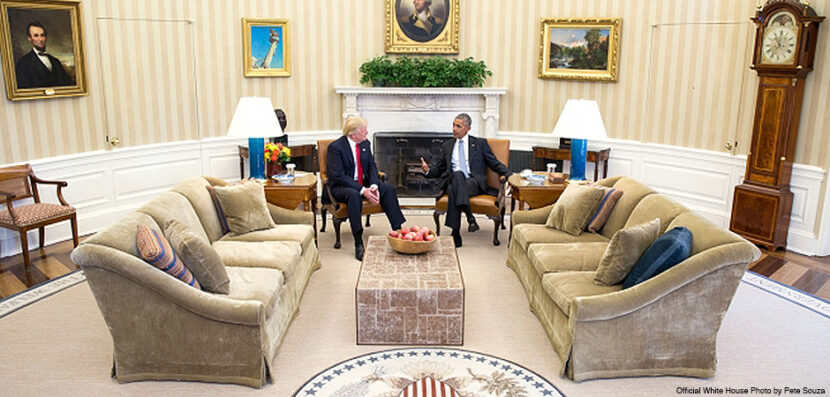- Current Events New Alabama Congressional District Selects Candidates
- Current Events Nebraska Rejects Winner-Take-All Proposal
- Citizenship Voting Under Age 18
- Citizenship Citizenship in Action
- Democratic Party Biden’s and Trump’s Recent Primary Results
- Elections Trump and Biden Win South Carolina and Michigan Primaries

The Trump Presidency Transition Plan
Now that the unexpectedness of the election result has settled, people are beginning to look ahead to January 20–the day president-elect Donald Trump will take office–and imagine what a Trump presidency will actually look like. In October, Trump published “Donald Trump’s Contract With the American Voter,” which lays out his plan for his first 100 days in office and gives good insight into what his priorities will be once he assumes the presidency in early 2017.
An Ambitious Contract
Trump’s “Contract” focuses mostly on three major ideas: eliminating corruption in the government, helping American workers, and restoring security and the rule of law.
His plan to eliminate government corruption includes imposing term limits on members of Congress; putting a hiring freeze on federal workers; eliminating two existing federal regulations for each new one that is added; and changing the ground rules for federal lobbyists.
Trump’s plans to help American workers include renegotiating or withdrawing from the North American Free Trade Agreement (NAFTA); withdrawing from the TPP (Trans-Pacific Partnership); lifting environmental restrictions on job-producing energy resources (including shale, oil, natural gas, and coal); allowing energy projects such as the controversial Keystone Pipeline to move forward; and canceling participation in costly United Nations climate change programs.
Finally, Trump pledges to restore security and the rule of law by immediately cancelling President Obama’s so-called “unconstitutional” executive orders; securing a new Supreme Court justice to replace Justice Scalia; removing over two million illegal immigrants; and establishing an immigration ban on Muslims.
In addition, during his first 100 days, he also plans to put forth legislation that will revamp the tax code; end common core and allow greater school choice; repeal the Affordable Health Care Act (“Obamacare”), and build a wall along our southern border with Mexico.
Reactions to Trump’s Plans
Many people, especially minority groups and immigrants, have voiced concern and even fear over President-elect Trump’s proposed plans. However, it is important to remember that the president is not a king; his or her power is limited by the other branches of government, by laws that already exist, and by the Constitution itself. While it is likely that a Republican-run Congress will go along with much of what Mr. Trump proposes–such as repealing “Obamacare” and revamping the tax code and border security–Senate Majority Leader Mitch McConnell has already expressed opposition to some of his plans. For example, the Senate says it will not move forward on imposing term limits for Congress.
Furthermore, it is unlikely that President-elect Trump will be able to accomplish such an ambitious plan in such a short period of time. He will be caught up instead in the work of building a cabinet and assembling a staff, as well as gaining the approval of the majority of Americans who did not vote for him and may not agree with the changes he wishes to implement.
Building a Cabinet
The transition to a Trump administration involves much more than just President-elect Trump moving into the Oval Office. In fact, the incoming administration must fill roughly 4,000 political appointments. Trump is expected to do this largely by awarding positions to people who were loyal to him during his campaign. He has also stated that he would like to fill his cabinet and senior staff with military generals and with people from the private sector, such as business executives, rather than with traditional politicians.
However, Trump may face several difficulties when building his cabinet. First, many top politicians have spoken out against him during the course of his controversial campaign. Secondly, high-profile women might be reluctant to serve in a Trump administration due to Trump’s sexist comments and behavior over the last few months.
Though Trump and his team have not yet declared all of their cabinet choices, the ones they have announced so far are already controversial. For chief of staff, perhaps the most influential position, the president-elect has chosen Reince Priebus, the chairman of the Republican National Committee. For chief strategist and senior counselor, Trump has appointed Steven Bannon, his campaign chief: a decision which many civil rights groups have already denounced based on Bannon’s history of racism and nationalism. For Secretary of State, frontrunners include former House Speaker Newt Gingrich, or Senator Bob Corker, current chairman of the Senate Foreign Relations Committee. For Treasury secretary, Trump has hinted at Steven Mnuchin, the chief executive of a private investment firm. And it is widely thought by experts that former New York City mayor Rudy Giuliani, a loyal Trump supporter, will likely become attorney general.
Trump has also stated that he would like to reduce (or eliminate altogether) the Education Department. And while he originally suggested eliminating the Environmental Protection Agency (EPA) as well, he has since agreed to keep it but will refocus its mission on ensuring clean air and water. No matter who is chosen to lead the EPA, addressing climate change will not be a priority under the Trump administration.


